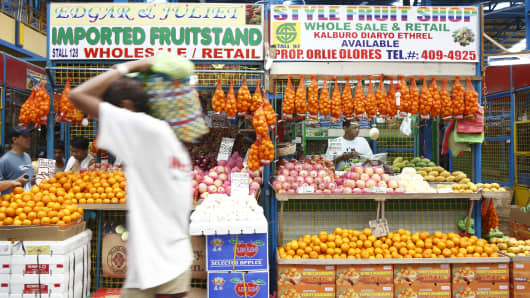Philippines still 'star of Asia' despite GDP miss
Katie Holliday | @hollidaykatie
The Philippines posted weaker-than-expected first quarter growth, but Southeast Asia's 'rising star' economy is still rising, analysts say.
Gross domestic product (GDP) expanded 5.7 percent from January to March, official data showed Thursday, below expectations for a 6.3 percent rise and marking the first sub-6 percent growth rate in nine quarters.
But analysts don't believe growth momentum has been derailed.
"Overall, the Philippines remains the bright spot in Asia. We expect GDP to gain momentum in the next quarters. The upside risk is that reconstruction activities may give a stronger impetus to growth and compensate Q1 under performance," Cynthia Jane Kalasopatan of Singapore's Mizuho Bank told CNBC.
Robust growth in recent years earned the Philippines the title 'Asia's rising star.' In 2013, it was Asia-Pacific's second fastest growing economy after China with growth of 7.2 percent.
But the economy was hit hard by a typhoon in November that killed 6,000 people and damaged crops. Analysts were concerned about the economic recovery, especially given the country's high unemployment and poverty rates.
The government began its reconstruction spending program earlier this year, but the effects were not as immediate as hoped, Mizuho's Kalasopatan said.
"It appears that the effects of Typhoon Haiyan were more severely felt in Q1. The breakdown of GDP components reveals that government spending was not as strong as expected," she said, adding that consumption also made a weaker growth contribution compared with the previous quarter. The poor performance in the nation's stock market also dampened growth.
Despite these negative factors the economy shows signs of resilience; this led Kalasopatan to maintain her 2014 growth forecast of 6.5 percent.
Private investment and net exports have surprised to the upside, Kalasopatan said. She expects reconstruction activity - another key growth driver - to pick up soon.
Gross domestic product (GDP) expanded 5.7 percent from January to March, official data showed Thursday, below expectations for a 6.3 percent rise and marking the first sub-6 percent growth rate in nine quarters.
But analysts don't believe growth momentum has been derailed.
"Overall, the Philippines remains the bright spot in Asia. We expect GDP to gain momentum in the next quarters. The upside risk is that reconstruction activities may give a stronger impetus to growth and compensate Q1 under performance," Cynthia Jane Kalasopatan of Singapore's Mizuho Bank told CNBC.
Robust growth in recent years earned the Philippines the title 'Asia's rising star.' In 2013, it was Asia-Pacific's second fastest growing economy after China with growth of 7.2 percent.
But the economy was hit hard by a typhoon in November that killed 6,000 people and damaged crops. Analysts were concerned about the economic recovery, especially given the country's high unemployment and poverty rates.
The government began its reconstruction spending program earlier this year, but the effects were not as immediate as hoped, Mizuho's Kalasopatan said.
"It appears that the effects of Typhoon Haiyan were more severely felt in Q1. The breakdown of GDP components reveals that government spending was not as strong as expected," she said, adding that consumption also made a weaker growth contribution compared with the previous quarter. The poor performance in the nation's stock market also dampened growth.
Despite these negative factors the economy shows signs of resilience; this led Kalasopatan to maintain her 2014 growth forecast of 6.5 percent.
Private investment and net exports have surprised to the upside, Kalasopatan said. She expects reconstruction activity - another key growth driver - to pick up soon.
Other economists told CNBC the GDP number was a temporary setback. They are bullish on the prospect for a bounce back.
"We expect a rebound over the coming quarters, which would ensure the Philippines remains one of the region's strongest performers," said Daniel Martin, Asia economist at Capital Economics.
"The breakdown of the data was more encouraging than the headline numbers," he added.
Martin highlighted fixed capital formation, which grew to 11.2 percent compared with 8 percent in the previous quarter; exports, which rose to 12.6 percent compared with 3.6 percent; and public spending, which rose 2 percent after contracting in the previous quarter.
Other encouraging factors include resilient household spending despite higher food prices following the typhoon, said Martin. Remittances - wages sent home by Filipinos working overseas - will likely continue to support households.
"The broader demand outlook is still robust... we do not see the weak Q1 growth figure as part of a sustained slowdown," he said, adding that Capital Economics maintains its 2014 and 2015 growth forecasts of 6.5 percent and 7 percent.
"We expect a rebound over the coming quarters, which would ensure the Philippines remains one of the region's strongest performers," said Daniel Martin, Asia economist at Capital Economics.
"The breakdown of the data was more encouraging than the headline numbers," he added.
Martin highlighted fixed capital formation, which grew to 11.2 percent compared with 8 percent in the previous quarter; exports, which rose to 12.6 percent compared with 3.6 percent; and public spending, which rose 2 percent after contracting in the previous quarter.
Other encouraging factors include resilient household spending despite higher food prices following the typhoon, said Martin. Remittances - wages sent home by Filipinos working overseas - will likely continue to support households.
"The broader demand outlook is still robust... we do not see the weak Q1 growth figure as part of a sustained slowdown," he said, adding that Capital Economics maintains its 2014 and 2015 growth forecasts of 6.5 percent and 7 percent.

No comments:
Post a Comment